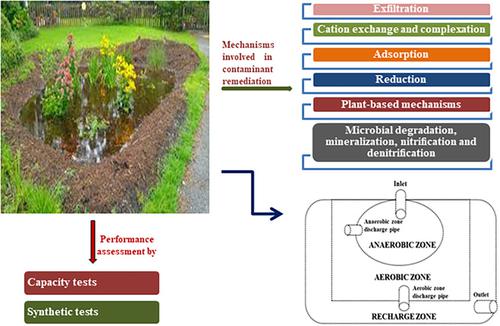当前位置:
X-MOL 学术
›
WIREs Water
›
论文详情
Our official English website, www.x-mol.net, welcomes your feedback! (Note: you will need to create a separate account there.)
Management of stormwater pollution using green infrastructure: The role of rain gardens
WIREs Water ( IF 8.2 ) Pub Date : 2021-01-06 , DOI: 10.1002/wat2.1507 Rozi Sharma 1 , Piyush Malaviya 1
WIREs Water ( IF 8.2 ) Pub Date : 2021-01-06 , DOI: 10.1002/wat2.1507 Rozi Sharma 1 , Piyush Malaviya 1
Affiliation

|
Major modifications are needed in existing stormwater management practices to control floods in urban landscapes, protect natural ecosystems, and minimize infrastructural destruction due to stormwater hazards. Stormwater management combined with urban design can be the best solution to minimize urban flooding risks and promote a clean natural environment. Green infrastructure (GI) is an environmentally sustainable alternative to traditional methods of stormwater management. Rain gardens, a GI, play a vital role in reducing rainwater volume and flow, prevent asset's destruction, remove pollutants from urban runoff, and recharge groundwater. Rain gardens can remove sediments, heavy metals, pathogens, nutrients, hydrocarbons from stormwater via several mechanisms. Various amendments in soil media help in delayed saturation, low sorption capacity, limited pollutant mobility, and bioaccumulation/biotransformation of metals/organic compounds in rain gardens. Soil media and plants play a vital role in the pollutant removal processes of rain gardens. Various plant‐based mechanisms and chemical processes like adsorption, reduction, sedimentation, cation‐exchange capacity, complexation, and so forth are involved in the removal of contaminants from stormwater. Construction and design considerations; different models of rain gardens; working mechanisms; performance assessment tools like capacity tests and synthetic runoff tests; removal of stormwater pollutants, and biphasic rain gardens have been critically discussed in this review. The state‐of‐the‐art review approaches to provide fundamental knowledge of rain gardens and in‐depth analyzes its potential as a stormwater management tool. Future directions on improving efficiencies of rain gardens have also been discussed for prospective researchers.
中文翻译:

使用绿色基础设施管理雨水污染:雨水花园的作用
现有的雨水管理实践需要进行重大修改,以控制城市景观中的洪水,保护自然生态系统并最大程度地减少因雨水灾害造成的基础设施破坏。雨水管理与城市设计相结合,可以是最大程度地减少城市洪灾风险并促进清洁自然环境的最佳解决方案。绿色基础设施(GI)是传统雨水管理方法在环境上可持续的替代方法。雨林是地理标志,在减少雨水量和流量,防止资产被破坏,清除城市径流中的污染物以及补充地下水方面发挥着至关重要的作用。雨水花园可以通过多种机制清除雨水中的沉积物,重金属,病原体,营养物质和碳氢化合物。土壤介质的各种改良有助于延迟饱和,低吸附能力,有限的污染物迁移率,以及雨水花园中金属/有机化合物的生物累积/生物转化。土壤介质和植物在雨花园的污染物去除过程中起着至关重要的作用。各种植物性机制和化学过程(例如吸附,还原,沉淀,阳离子交换能力,络合等)都涉及从雨水中去除污染物。施工和设计注意事项;不同型号的雨水花园;工作机制;性能评估工具,例如容量测试和合成径流测试;在这篇评论中,讨论了去除雨水污染物和双相雨水花园的问题。最新的审查方法可提供有关雨花园的基础知识,并深入分析其作为雨水管理工具的潜力。
更新日期:2021-02-05
中文翻译:

使用绿色基础设施管理雨水污染:雨水花园的作用
现有的雨水管理实践需要进行重大修改,以控制城市景观中的洪水,保护自然生态系统并最大程度地减少因雨水灾害造成的基础设施破坏。雨水管理与城市设计相结合,可以是最大程度地减少城市洪灾风险并促进清洁自然环境的最佳解决方案。绿色基础设施(GI)是传统雨水管理方法在环境上可持续的替代方法。雨林是地理标志,在减少雨水量和流量,防止资产被破坏,清除城市径流中的污染物以及补充地下水方面发挥着至关重要的作用。雨水花园可以通过多种机制清除雨水中的沉积物,重金属,病原体,营养物质和碳氢化合物。土壤介质的各种改良有助于延迟饱和,低吸附能力,有限的污染物迁移率,以及雨水花园中金属/有机化合物的生物累积/生物转化。土壤介质和植物在雨花园的污染物去除过程中起着至关重要的作用。各种植物性机制和化学过程(例如吸附,还原,沉淀,阳离子交换能力,络合等)都涉及从雨水中去除污染物。施工和设计注意事项;不同型号的雨水花园;工作机制;性能评估工具,例如容量测试和合成径流测试;在这篇评论中,讨论了去除雨水污染物和双相雨水花园的问题。最新的审查方法可提供有关雨花园的基础知识,并深入分析其作为雨水管理工具的潜力。



























 京公网安备 11010802027423号
京公网安备 11010802027423号